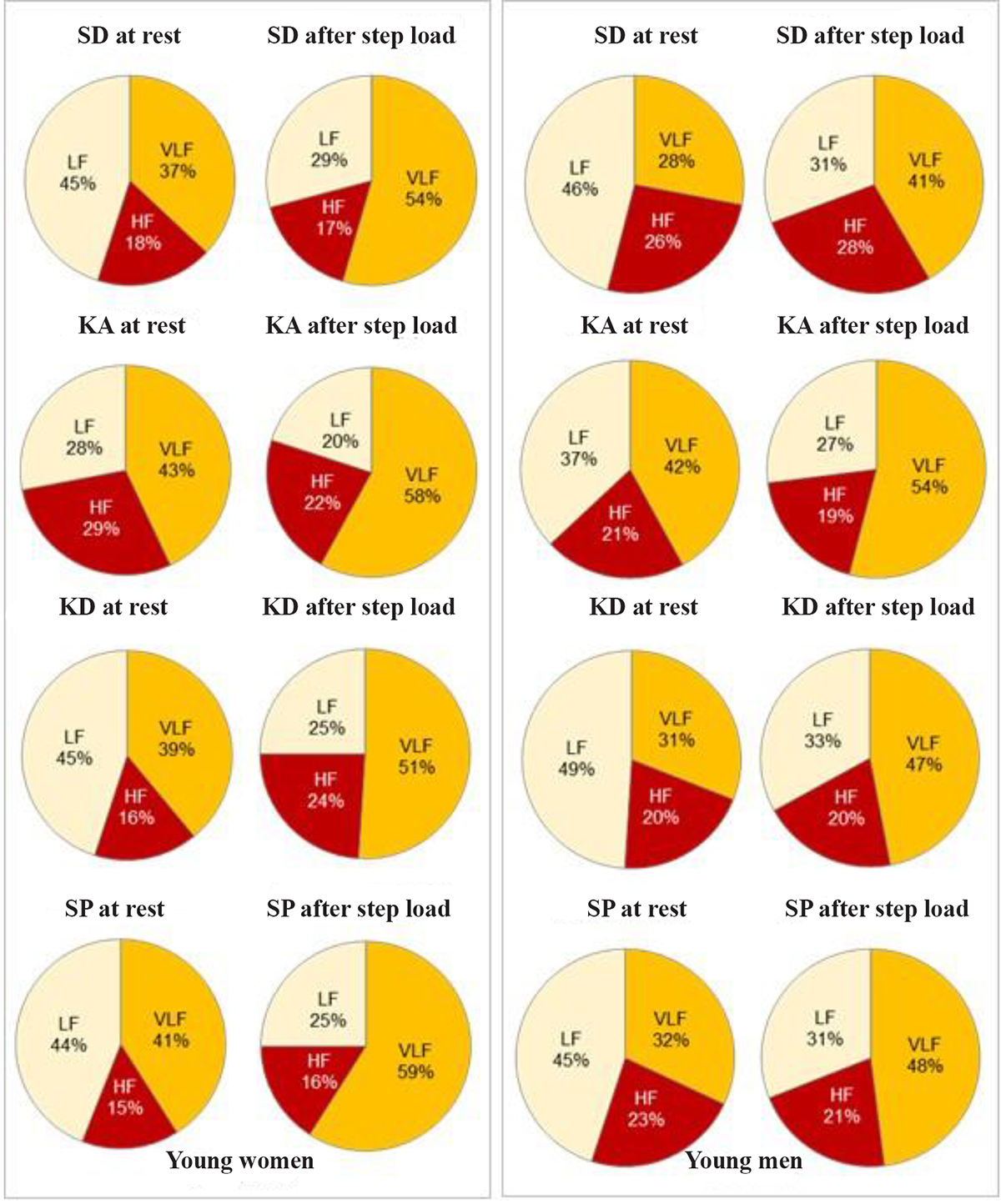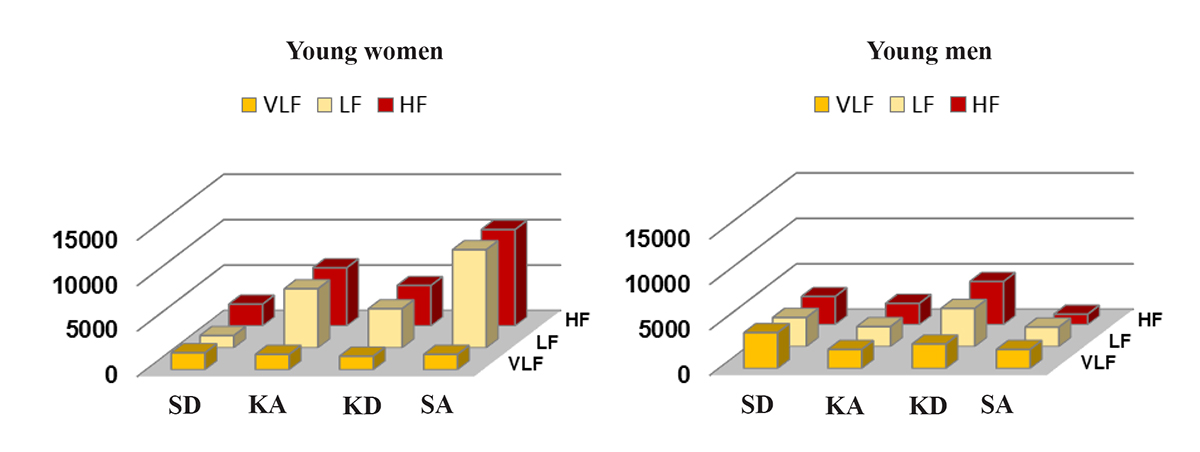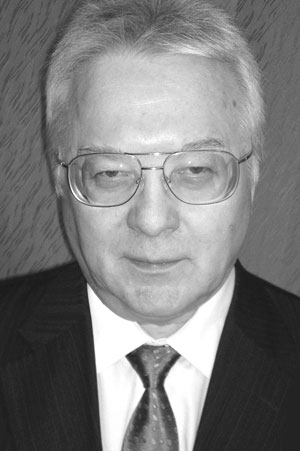Effect of exercise on parameters of HRV power spectrum of track and field athletes at latitudinal relocation
Фотографии:
ˑ:
Dr.Biol., Professor S.I. Loginov
O.N. Shimshieva
Surgut state university, Surgut
Keywords: heart rate variability, step load, track and field athletes, young women, young men, age of 15-18 years, stochastics, method of multidimensional phase spaces, chaos-self-organization theory, latitudinal relocation.
Introduction. It becomes an objective necessity to carry out a bioinformatic analysis of training effects of exercise on the human body [6]. Training of athletes in the urbanized Yugra North is carried out in uncomfortable environmental and climatic conditions that have chaotic dynamics of manifestations [5, 7], forcing the athletes of KhMAR picked teams to travel regularly to the South of Russia for training camps. During latitudinal relocation athletes’ bodies undergo major physiological changes that are not studied enough to date.
The purpose of the research was to make a comparative study of the dynamics of the functional state of the bodies of young male and female track and field athletes under the influence of exercise during latitudinal relocation according to the power spectrum of heart rate variability from the standpoint of the deterministic-stochastic approach (DSA) and the chaos-self-organization theory (CSOT).
Research method and organization. 30 young women and young men of 15-18 years of age specializing in sprint kinds of athletics were involved in the study. All of them were members of the KhMAD-Yugra picked team and first-class athletes. The spectral characteristics of heart rate variability (HRV) before and after step load presented by high-intensity 30-second run in place while lifting hips high were studied using pulse oximeter “Elox-01S2” (Samara, RF). Pulsogram was recorded during 5 minutes in the sitting position in a state of relative rest and after the step load. Four data blocks were obtained labelled by us as “Surgut – departure”, “Kislovodsk – arrival”, “Kislovodsk – departure” and “Surgut – arrival”. One hundred and twenty measurements were made in total. Statistical calculations were carried out using Statistica 6.0 (StatSoft, USA). Wilcoxon test for groups with non-parametric distribution was used to assess differences. The median and 0.95 confidence interval were calculated. The data compliance with the normal distribution law was verified on the basis of the Shapiro-Wilk test. Alternatively obtained data were processed using the method of multidimensional phase spaces [4].
Research results and discussion. Dynamics of HRV power spectrum at rest and after the step load in different places in the North and in the South is complex and multidirectional. Nevertheless, analysis of the absolute values of the power spectrum (PS) indicators in all the three ranges revealed certain patterns. Comparison of heart rate SM values before and after the step load in Surgut before departure revealed an increase of VLF (from 1,486 to 2,622 ms2), while other indicators changed insignificantly: LF decreased from 2,431 to 1,913 ms2, HF increased from 1,367 to 1,726 ms2, Total also increased insignificantly from 6,633 to 6,948 ms2.
After the flight from Surgut to Kislovodsk the absolute values of the very low frequency (VLF) waves of the young women increased 2 times in response to the step load (from 5,108 to 10,709 ms2), the power of the low frequency (LF) waves did not change (3,349 vs 3,669 ms2), the power of the high frequency (HF) waves increased insignificantly (from 3,354 to 4,089 ms2), the Total increased from 11,811 to 18,467 ms2.
At the end of the training camp (TC) in Kislovodsk VLF values at rest decreased 2 times (from 10,709 to 5,581 ms2), LF – from 3,669 to 2,793 ms2, HF –1.5 times (from 4,089 to 2,682 ms2), Total decreased 2 times (from 26,092 to 13,502 ms2) versus the reference values. No significant changes were observed as compared with the response to the before-departure load – supposedly due to the fact that the body was almost back to its original state in terms of these parameters (before leaving for the TC). The indicators that significantly increased in Surgut compared with the end of the training camp were as follows: VLF and LF 3 times, HF – 1.5 times, Total – 2 times.
VLF, LF and HF percentage before the load in Surgut was 37, 45 and 18 for young women and 28, 46 and 26 for young men, respectively, of the Total, and after the load it was 54, 29, 17 and 42, 31, 28 %, respectively (Figure 1).
The data shown in Figure 1 clearly indicate that within the SD cluster (Surgut Departure) the power spectrum dominated in the LF range for both young women and young men (45 and 46% of Total, respectively). VLF reacted most dynamically to the step load (54 and 42% of Total, respectively). Relocation to Kislovodsk (Kislovodsk Arrival) was marked by an increase of HF share from 16% to 29% for young women and an increase of VLF from 28 to 42% for young men versus Surgut. Males and females reacted the same way to the load by increasing VLF to 58 and 54% of the current Total, respectively. The end of the training camp (the KD cluster) at rest was accompanied by an increase of the share of LF for young women and young men from 28 to 45 and from 37 to 49% versus KA, respectively (Figure 1).

Figure 1. Change of the spectral parameters of HRV under the influence of step load.
Legend: SD – Surgut departure, KA – Kislovodsk arrival, KD – Kislovodsk departure, SA – Surgut Arrival. Power spectrum percentages: power spectrum of very low frequency waves, LF – power of low frequency waves, HF – power of high frequency waves.
Change of the heart rate power spectrum percentages in various locations evidently displays the stochastic dynamics of the working structures of the central and autonomous regulation circuits. However, heart rate is not a strictly stochastic process with ergodic properties [1, 2, 3]. Heart rate variability shows the controlling impact of various structures with non-linear performance that needs to be considered from the standpoint of the chaos-self-organization theory [8].
Volume of quasi-attractor (QAV) is a measure of randomness, a kind of cloud of dots within the system of phase coordinates. QAV of spectral parameters increased 4.4 times for young women under the load in SD (from 5.7×1012 to 25.1×1012 c.u.). Step load that took place in the first days in Kislovodsk (KA) caused an insignificant decrease of QAV (from 7.26×1012 to 5.77×1012 c.u.). After a stay of two weeks, before leaving Kislovodsk (KD) the step load performance was accompanied by a decrease of QAV 3 times (from 19.8×1012 to 6.31×1012 c.u.) (Table 1). This decrease indicates a reduction in the degree of chaos reactions of the bodies of young women in response to the step load and is associated with adaptation. Upon arrival in Surgut QAV considerably increased, but hardly changed under the step load (87.01×1012 vs 81.21×1012 c.u.). In this regard, it can be assumed that the relocation back to the North was accompanied by a re-activation of the functional systems of the body of young women seen in the spectral parameters of HRV.
Table 1. Measurement data of parameters of quasi-attractors in a 4-dimensional phase space of spectral indicators of variational pulsogram before and after load for young women
|
Intervals |
Surgut, departure |
Kislovodsk, arrival |
Kislovodsk, departure |
Surgut, arrival |
||||
|
Before |
After |
Before |
After |
Before |
After |
Before |
After |
|
|
Х1 |
16,139 |
25,813 |
25,543 |
32,540 |
14,281 |
23,293.0 |
30,760 |
59,334 |
|
Х2 |
10,234 |
10,075 |
10,437 |
6,183 |
11,131 |
6,648.0 |
15,004 |
20,709 |
|
Х3 |
7,503 |
13,759 |
9,110 |
11,808 |
8,614 |
10,416.0 |
22,154 |
18,670 |
|
Х4 |
4.61 |
7.01 |
2.99 |
2.43 |
14.46 |
3.91 |
8.51 |
3.54 |
|
VX |
5.7×1012 |
25.1×1012 |
7.26×1012 |
5.77×1012 |
19.8×1012 |
6.31×1012 |
87.01×1012 |
81.21×1012 |
|
Asymmetry |
Before |
After |
Before |
After |
Before |
After |
Before |
After |
|
rX1 |
0.28 |
0.30 |
0.26 |
0.12 |
0.25 |
0.17 |
0.26 |
0.23 |
|
rX2 |
0.19 |
0.28 |
0.17 |
0.04 |
0.25 |
0.06 |
0.14 |
0.24 |
|
rX3 |
0.16 |
0.29 |
0.13 |
0.11 |
0.24 |
0.21 |
0.32 |
0.24 |
|
rX4 |
0.07 |
0.21 |
0.02 |
0.18 |
0.29 |
0.22 |
0.21 |
0.13 |
|
rX |
5,018 |
9,159 |
6,964 |
3,980 |
4,904 |
4,591 |
10,875 |
15,306 |
Legend: Х1 – VLF (power spectrum of very low frequency waves); Х2 – LF (power of low frequency waves); Х3 – HF (power of high frequency waves); Х4 – LF/HF (vagosympathetic balance parameter); VX – total amount of quasi-attractor; rX – asymmetry index.
QAV at rest of young men increased 4 times after the relocation to Kislovodsk, that is, the system responded to the latitudinal relocation by increasing randomness. The system hardly changed at the end of the training camp. It can be assumed that the adaptive body changes in the athletes that occurred after the flight were stable and hardly changed by the end of the training camp. Right after the flight back (SA cluster) the volume of quasi-attractor at rest decreased 13 times, and in comparison with the SD cluster –3 times. That is, after coming back the chaotic state of the system was minimal compared to the other clusters of data which may indicate the maximum mobilization of the functional capabilities of athletes and chaos minimization.
Step load in various locations had a different impact on the bodies of young men. The volume of quasi-attractor did not change for the young men under the load in the SD cluster (Table 2), indicating an initially low degree of randomness of the system. Similar load during the first days upon arriving in Kislovodsk caused an increase in the quasi-attractor volume 2 times, which corresponded to a greater degree of randomness of the system.
Table 2. Measurement data of parameters of quasi-attractors in a 4-dimensional phase space of spectral indicators of variational pulsogram before and after the load for young men
|
Intervals |
Surgut, departure |
Kislovodsk, arrival |
Kislovodsk, departure |
Surgut, arrival |
||||
|
Before |
After |
Before |
After |
Before |
After |
Before |
After |
|
|
Х1 |
13,995 |
27,442 |
20,653 |
19,959 |
19,017 |
4,043 |
6,081 |
3,407 |
|
Х2 |
7,645 |
5,711 |
6,709 |
18,307 |
15,356 |
5,954.0 |
4,945 |
6,160 |
|
Х3 |
7,036 |
4,686 |
6,540 |
10,980 |
8,625 |
7,258.0 |
6,890 |
11,188 |
|
Х4 |
4.41 |
4.56 |
12.68 |
6.31 |
5.28 |
2.09 |
3.72 |
3.62 |
|
VX |
3.32×1012 |
3.35×1012 |
11.5×1012 |
25.3×1012 |
13.3×1012 |
0.37×1012 |
0.77×1012 |
0.85×1012 |
|
Asymmetry |
Before |
After |
Before |
After |
Before |
After |
Before |
After |
|
rX1 |
0.23 |
0.37 |
0.30 |
0.21 |
0.25 |
0.12 |
0.12 |
0.05 |
|
rX2 |
0.11 |
0.15 |
0.03 |
0.20 |
0.22 |
0.16 |
0.18 |
0.08 |
|
rX3 |
0.29 |
0.16 |
0.28 |
0.13 |
0.20 |
0.28 |
0.33 |
0.24 |
|
rX4 |
0.009 |
0.27 |
0.27 |
0.23 |
0.24 |
0.01 |
0.20 |
0.23 |
|
rX |
3,848 |
10,269 |
6,434 |
5,755 |
6,084 |
2,301 |
2,553 |
2,765 |
Legend: Same as in Table 1.
Calculation of the leading order parameters that had a significant impact on the performance of the vector of HRV spectral characteristics in various locations is presented in Figure 2 (the leading parameter is the shortest column in Figure). It is easy to see that the leading order parameter of the young women in SD was the index of LF that reflects the activity of the sympathetic division of the ANS. Upon arrival to the training camp (KA cluster) VLF became the leading order parameter reflecting the activity of the central ergotropic and humoral-metabolic mechanisms of heart rate regulation. VLF remained so in KD and SA.

Figure 2. Measurement data of the order parameters of the vector of spectral indices of young women (n=15) and young men (n=15) before and after step load excluding diagnostic indicators: SD – Surgut Departure; KA – Kislovodsk Arrival; KD – Kislovodsk Departure; SA – Surgut Arrival. On the abscissa – places of staying, location; on the ordinate – values of indicators, c.u.; on Z-axis – power spectrum indicators, ms2.
The data in Figure 2 indicate that the change of the leading order parameters of the young men differed from that of the young women and took place under the scheme SD – LF/HF, KA and KD – VLF, SA – HF. Parity influence of the sympathetic and parasympathetic divisions of the ANS was observed in Surgut. Neuro-humoral regulation prevailed in Kislovodsk that ensured homeostasis of the body during high-intensity physical activity in the new conditions. HF index that reflects the influence of the vagus nerves became a leading order parameter determining the performance of the whole system upon arrival in Surgut.
When comparing the absolute values of the heart rate power spectrum parameters derived from statistical calculations, their percentiles and leading order parameters under the step load in various locations it can be seen that they do not always coincide. This confirms the chaotic nature of the functioning of the heart rate regulation system during exercise.
Conclusion. In order to assess the impact of step load the characteristics of the order of LF and HF should be controlled in Surgut, VLF - in the south and HF components on arrival to the north in young men. As for girls LF is the most informative index in Surgut and VLF - in the South and on their arrival to the North, and this is the feature of the response to step load of the body of young track and field athletes under changing conditions.
References
- Babunts, I.V. Azbuka analiza variabel'nosti serdechnogo ritma (The ABC of heart rate variability analysis) / I.V. Babunts, E.M. Miridzhanyan, Yu.A. Mashaekh. – Stavropol', 2002. – 112 P.
- Baevskiy, R.M., Ivanov, G. G., Chireykin, L.V., Gavrilushkin, A.P. et al. Analiz variabel'nosti serdechnogo ritma s ispol'zovaniem razlichnyh jelektrokardiograficheskih sistem (Heart rate variability analysis using different electrocardiographic systems) / R.M. Baevskiy G.G. Ivanov, L.V. Chireykin, A.P. Gavrilushkin et al. // Vestnik aritmologii. – 2001. – № 24. P. – 65–87.
- Dimitriev, D.A., Saperova, E.V. Variabel'nost' serdechnogo ritma i arterial'noe davlenie pri mental'nom stresse (Heart rate variability and blood pressure during mental stress) / D.A. Dimitriev, E.V. Saperova // Rossiyskiy fiziologicheskiy zhurnal im. I.M. Sechenova. – 2015. – V. 101. – № 1. P. 98–107.
- Es'kov, V.M. Programma identifikatsii parametrov attraktorov povedeniya vektora sostoyaniya biosistem v m-mernom prostranstve (Program for identification of parameters of attractors of activity of biosystem state vector in m-dimensional space) / V.M. Es'kov, M.Ya. Braginskiy, S.N. Rusak, A.A. Ustimenko, Yu.V. Dobrynin. – Svidetel'stvo ob ofitsial'noy registratsii programmy dlya EVM № 2006613212. ROSPATENT. – Moscow, 2006.
- Povzun, A.A. Sravnitel'ny analiz sezonnogo izmeneniya adaptatsionnykh vozmozhnostey organizma sportsmenok-lyzhnits po pokazatelyam biologicheskogo ritma (Comparative analysis of seasonal change of body's adaptive capabilities in women's skiing in terms of biorhythms) / A.A. Povzun // Teoriya i praktika fizicheskoy kul'tury. – 2010. – № 8. – P. 95–99.
- Shimshieva, O.N., Loginov, S.I. Vliyanie fizicheskoy nagruzki na parametry variabel'nosti serdechnogo ritma yunoshey pri shirotnom peremeshchenii (Heart rate variability parameters of young men under exercise at latitudinal relocation) // Teoriya i praktika fizicheskoy kul'tury. 2014. № 6. P. 87-90.
- Shimshieva, O.N. Bioinformatsionny analiz vliyaniya fizicheskoy nagruzki na parametry serdechno-sosudistoy sistemy sportsmenov pri shirotnom peremeshchenii (Bioinformatic analysis of the impact of exercise on cardiovascular characteristics of athletes at latitudinal relocation) / O.N. Shimshieva, A.S. Snigirev, S.I. Loginov, Ju.S. Efimova // Teoriya i praktika fizicheskoy kul'tury. – 2014. – № 5. – P. 83–85.
- Beaumont, A., Burton, A., Lemon, J., Bennett, B., Lloyd, A., Vollmer-Conna, U. Reduced cardiac vagal modulation impacts on cognitive performance in chronic fatigue syndrome // PLoS One. 2012. V. 7, N 11: e49518. doi: 10.1371/journal.pone.0049518.
Corresponding author: apokin_vv@mail.ru


